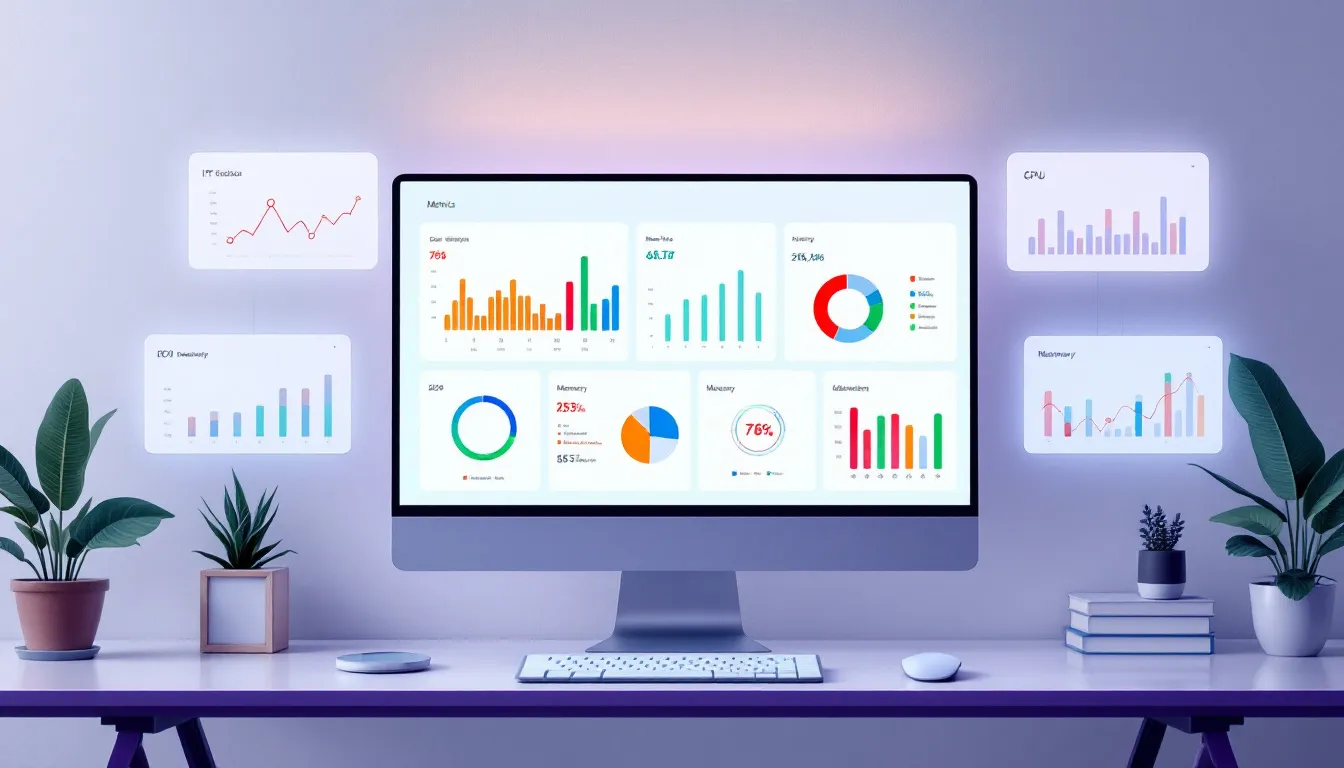AI-driven anomaly detection systems can accurately identify unusual patterns or data points that deviate from expected behavior across various industries:
Construction
- Detect potential hazards, errors, and inefficiencies in real-time
- Prevent accidents, reduce costs, and improve productivity
- Scalable for projects of all sizes
- Companies like Doxel use AI-enhanced systems for real-time site monitoring
Manufacturing
- Identify anomalies before equipment failure, product defects, or supply chain disruptions
- Scalable for operations of any size
- Customizable to meet specific manufacturing needs
- Siemens uses AI for real-time monitoring and proactive maintenance
Energy Optimization
- Detect anomalies in energy consumption data
- Reduce energy waste and optimize usage
- Scalable for facilities of any size
- Siemens' AI system enables proactive energy optimization measures
Cybersecurity
- Accurately detect unknown and emerging cyber threats in real-time
- Scalable to handle large volumes of data and growing networks
- Tailored to meet cybersecurity regulations and requirements
- IBM uses AI to detect potential threats and prevent security breaches
Healthcare
- Accurately identify anomalies in medical data for early disease detection
- Process large volumes of data in real-time
- Customizable to meet healthcare regulations like HIPAA and GDPR
- Google's DeepMind Health uses AI to detect tumors and fractures from medical images
Advantages
- Better accuracy in anomaly detection
- Faster processing of large datasets
- Scalability for large-scale operations
- Fewer false positives, minimizing manual intervention
Limitations
- Dependence on quality of training data
- Lack of transparency in decision-making process
- Risk of perpetuating biases in training data
- Need for continuous training and updating
The Future
- Improved capabilities for real-time anomaly detection and swift response
- Integration with IoT and edge computing for diverse data analysis
- Becoming an essential component of modern security frameworks
- Continuous improvement in accuracy and effectiveness
Related video from YouTube
1. Using AI to Detect Anomalies in Construction Projects
Construction Industry Needs
The construction industry faces increasing project complexity, making efficient and accurate site monitoring crucial. AI-driven anomaly detection can identify potential hazards, errors, and inefficiencies in real-time, allowing construction companies to take proactive measures to prevent accidents, reduce costs, and improve productivity.
Accurate Results
AI algorithms can analyze real-time data from sensors, cameras, and drones to detect anomalies with high accuracy. This enables construction companies to identify potential issues before they become major problems, reducing risks of accidents, delays, and cost overruns.
Scalable Solution
AI-driven anomaly detection is highly scalable, making it suitable for construction projects of all sizes. From small residential projects to large-scale commercial developments, AI algorithms can be easily integrated into existing systems for real-time monitoring and analysis.
Efficient Analysis
AI-driven anomaly detection is computationally efficient, enabling fast and accurate analysis of large datasets. This is crucial in the construction industry, where timely decision-making is essential for meeting project timelines and budgets.
Real-World Example
Doxel, a Silicon Valley startup, uses rugged robots and drones equipped with cameras and LiDAR sensors to monitor construction sites and detect anomalies in real-time. By leveraging AI algorithms, Doxel's system can identify potential issues before they become major problems, enabling construction companies to take proactive measures to prevent accidents, reduce costs, and improve productivity.
| Advantage | Description |
|---|---|
| Accurate Results | AI algorithms analyze real-time data from various sources to detect anomalies with high accuracy. |
| Scalable Solution | AI-driven anomaly detection is suitable for construction projects of all sizes. |
| Efficient Analysis | AI enables fast and accurate analysis of large datasets, crucial for timely decision-making. |
| Real-World Application | Companies like Doxel use AI-enhanced systems to monitor construction sites and detect anomalies in real-time. |
2. Using AI to Detect Anomalies in Manufacturing
Accurate Detection
AI algorithms can analyze real-time data from sensors, machines, and other sources to accurately identify unusual patterns or deviations from normal operations. This enables manufacturers to detect potential issues before they escalate into major problems, reducing the risk of equipment failure, product defects, and supply chain disruptions.
Scalable Solution
AI-driven anomaly detection systems can be easily scaled to accommodate manufacturing operations of any size, from small production lines to large industrial facilities. These systems seamlessly integrate with existing infrastructure for real-time monitoring and analysis.
Efficient Analysis
AI algorithms are computationally efficient, enabling rapid and accurate analysis of large datasets. This is crucial in manufacturing, where timely decision-making is essential to meet production deadlines and avoid costly downtime.
Tailored Solutions
Manufacturing companies have unique requirements for anomaly detection, such as real-time monitoring, high accuracy, and scalability. AI-driven solutions can be customized to meet these specific needs, providing manufacturers with a tailored system for their operations.
| Benefit | Description |
|---|---|
| Accurate Detection | AI algorithms accurately identify anomalies in real-time data. |
| Scalable Solution | AI systems can accommodate manufacturing operations of any size. |
| Efficient Analysis | AI enables rapid analysis of large datasets for timely decision-making. |
| Tailored Solutions | AI solutions can be customized to meet specific manufacturing needs. |
Real-World Example
Siemens, a global technology company, has developed an AI-driven anomaly detection system for manufacturing. This system monitors industrial equipment and processes, identifying potential issues before they lead to costly downtime or product defects. By leveraging AI algorithms, Siemens' solution provides manufacturers with accurate, real-time insights, enabling proactive maintenance and quality control measures.
3. Using AI to Optimize Energy Usage
Energy optimization is crucial for various industries like manufacturing, construction, and energy production. AI-driven anomaly detection helps identify unusual patterns in energy consumption, allowing organizations to reduce waste and optimize energy usage.
Accurate Detection
AI algorithms analyze real-time energy consumption data from sources like sensors and meters. This enables accurate detection of anomalies, such as equipment malfunction or energy theft, before they become major issues.
Scalable Systems
AI-driven anomaly detection systems can be scaled to accommodate energy optimization operations of any size, from small buildings to large industrial facilities. These systems integrate seamlessly with existing infrastructure for real-time monitoring and analysis.
Efficient Analysis
AI algorithms enable rapid and accurate analysis of large datasets. This is essential for timely decision-making to reduce energy waste and optimize consumption.
| Benefit | Description |
|---|---|
| Accurate Detection | AI accurately identifies anomalies in energy consumption data. |
| Scalable Systems | AI systems accommodate energy optimization operations of any size. |
| Efficient Analysis | AI enables rapid analysis of large datasets for timely decisions. |
Real-World Example
Siemens, a global technology company, has developed an AI-driven anomaly detection system for energy optimization. This system monitors energy consumption data from various sources, identifying potential issues before they lead to energy waste or equipment malfunction. By leveraging AI algorithms, Siemens' solution provides organizations with accurate, real-time insights, enabling proactive energy optimization measures.
sbb-itb-9890dba
4. Using AI to Detect Cyber Threats
Cybersecurity is crucial for protecting systems, networks, and data from cyber threats. AI-driven anomaly detection plays a vital role in identifying unknown and emerging threats in real-time, going beyond traditional methods that rely on predefined rules and signatures.
Accurate Threat Detection
AI algorithms can analyze vast amounts of data from various sources like network traffic, system logs, and user behavior. This enables accurate detection of anomalies, reducing false positives and false negatives. AI systems can also learn and improve their detection capabilities over time.
Scalable for Large Networks
Cybersecurity systems must handle large volumes of data and scale to accommodate growing networks and systems. AI-driven anomaly detection can process vast amounts of data in real-time, making it ideal for large-scale cybersecurity operations.
Meeting Specific Requirements
Cybersecurity has unique requirements, such as compliance with regulations like GDPR and HIPAA. AI-driven anomaly detection systems can be tailored to meet these domain-specific needs, ensuring organizations remain compliant while protecting their systems and data.
| Benefit | Description |
|---|---|
| Accurate Threat Detection | AI accurately identifies anomalies in cybersecurity data. |
| Scalable for Large Networks | AI systems can handle large volumes of data and scale to accommodate growing networks. |
| Meeting Specific Requirements | AI systems can be tailored to meet unique cybersecurity requirements. |
Real-World Example
IBM uses AI-driven anomaly detection in its cybersecurity solutions to help organizations detect and respond to threats in real-time. IBM's system analyzes network traffic, system logs, and user behavior to identify potential threats, reducing the risk of security breaches and data loss.
5. Using AI to Detect Health Issues
AI plays a crucial role in healthcare by identifying unusual patterns in medical data that may indicate health issues. This early detection can improve patient outcomes and save lives.
Accurate Detection
AI algorithms can analyze large amounts of medical data, such as images, patient records, and sensor data, to accurately identify anomalies. This enables healthcare professionals to detect diseases early, reducing the risk of misdiagnosis.
Handling Large Data Volumes
AI systems can process vast amounts of medical data in real-time, making them suitable for large-scale healthcare operations. This allows organizations to quickly respond to anomalies and detect diseases.
Meeting Healthcare Regulations
Healthcare has specific requirements, such as HIPAA and GDPR compliance. AI systems can be tailored to meet these needs, ensuring patient data protection and regulatory compliance.
| Benefit | Description |
|---|---|
| Accurate Detection | AI accurately identifies anomalies in medical data. |
| Handling Large Data Volumes | AI systems can process vast amounts of medical data in real-time. |
| Meeting Healthcare Regulations | AI systems can be tailored to meet healthcare regulations. |
Real-World Example
Google's DeepMind Health uses AI to analyze medical images and detect anomalies, such as tumors and fractures. This enables early disease detection, improving patient outcomes and reducing healthcare costs.
Advantages and limitations
Advantages
AI-powered anomaly detection offers several benefits:
- Better accuracy: AI algorithms can analyze large datasets and identify patterns that humans may miss, leading to more accurate anomaly detection.
- Faster processing: AI systems can process vast amounts of data in real-time, enabling rapid anomaly detection and response.
- Scalability: AI systems can handle large volumes of data, making them suitable for large-scale operations.
- Fewer false positives: AI algorithms can reduce the number of false positives, minimizing manual intervention and improving overall efficiency.
| Benefit | Description |
|---|---|
| Better accuracy | AI algorithms analyze large datasets for accurate anomaly detection. |
| Faster processing | AI systems process vast amounts of data in real-time. |
| Scalability | AI systems handle large volumes of data for large-scale operations. |
| Fewer false positives | AI algorithms minimize manual intervention and improve efficiency. |
Limitations
While AI-powered anomaly detection offers advantages, it also has some limitations:
- Data quality dependence: AI algorithms are only as good as the data they are trained on. Poor data quality can lead to inaccurate anomaly detection.
- Lack of transparency: AI systems can be complex and difficult to understand, making it challenging to explain why a particular anomaly was detected.
- Bias risk: AI algorithms can perpetuate biases present in the training data, leading to inaccurate or unfair anomaly detection.
- Continuous training need: AI systems require ongoing training and updating to adapt to changing patterns and anomalies.
| Limitation | Description |
|---|---|
| Data quality dependence | AI algorithms are only as good as the training data. |
| Lack of transparency | AI systems can be complex and difficult to interpret. |
| Bias risk | AI algorithms can perpetuate biases present in the training data. |
| Continuous training need | AI systems require ongoing training and updating. |
The future of AI in anomaly detection
AI technology for detecting anomalies is rapidly advancing. In the coming years, it will play a crucial role across various sectors, from finance to supply chain logistics. AI algorithms will uncover hidden insights from data, enabling informed decision-making.
Improved Capabilities
As AI evolves, anomaly detection systems will become more robust and effective. AI algorithms will learn from new data and threats, allowing organizations to:
- Detect anomalies in real-time
- Respond swiftly to security incidents
- Prevent costly downtime and losses
Integration with Other Technologies
The integration of AI with technologies like IoT and edge computing will expand anomaly detection capabilities. Systems will:
- Analyze vast amounts of data from diverse sources
- Detect anomalies with greater accuracy and speed
Essential Component
AI-powered anomaly detection will become an essential part of modern security frameworks. It will empower organizations to:
- Stay ahead of emerging threats
- Protect assets with confidence
| Benefit | Description |
|---|---|
| Real-time Detection | Detect anomalies as they occur |
| Swift Response | Respond quickly to security incidents |
| Prevent Losses | Avoid costly downtime and losses |
| Diverse Data Analysis | Analyze data from various sources |
| Accurate Detection | Identify anomalies with high precision |
| Threat Prevention | Stay ahead of emerging threats |
| Asset Protection | Safeguard organizational assets |
Continuous Improvement
As the technology advances, AI-powered anomaly detection systems will:
- Adapt to new data and threats
- Improve in accuracy and effectiveness
Organizations can expect AI-powered anomaly detection to become an indispensable tool for data analysis, security, and decision-making.



